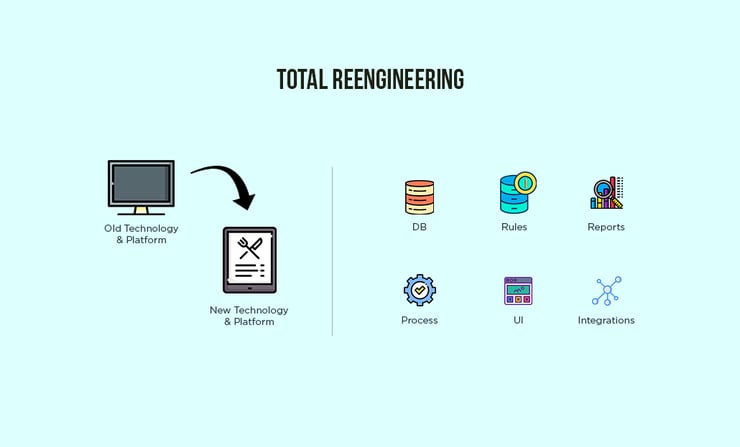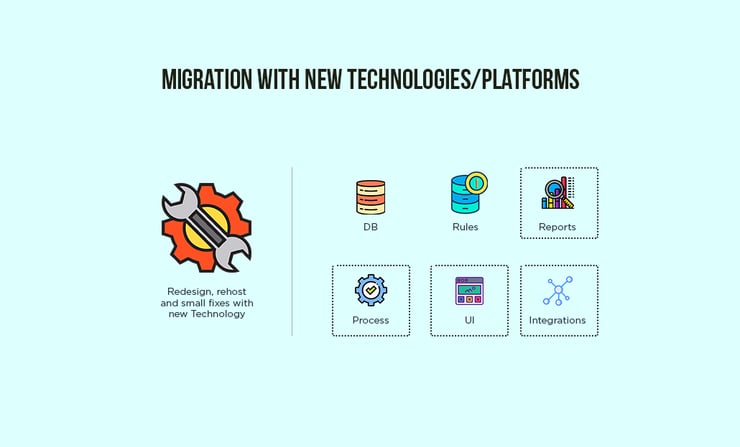Companies of all sizes are struggling with aging, complex legacy applications as they sit on the outdated technology, bloated with innovation, and difficult to support, maintain, scale or integrate with the new platforms.
Legacy applications are not always defined by their age, but might due to its inability or lack of support to meet the business growth requirements.
No one wants to teach these dinosaurs, new tricks, but they have to. Though outdated, they are critical to the operation of the enterprise. However, changing customer demands and business needs make it imperative for businesses to leverage new technologies.
Now, it is the peak time for them to modernize legacy applications to address the challenges of operational efficiency, agility and customer experience. As legacy modernization takes priority, a growing concern of failure forces several CIOs to question the value & validity of the modernization initiatives.
Value of Legacy Modernization
The main goal of the legacy application modernization process is adding effective value to the existing apps. Application modernization is the constant progress of transforming legacy systems to reduce IT costs and complexity, maintain data consistency, enhance process flexibility and enable cross-platform collaboration. It converts the existing system to a high-level modern web platform and integrates various related systems.
Considering Challenges & Risks
Beyond these benefits, most enterprises continue using legacy applications because of the cost and risk of replacing them. Enterprises are prone to face several challenges while carrying out a legacy modernization process. Few of them are
- Co-existence of Legacy & New Systems
- Quality Assurance
- Performance & scalability
- Modernization cost & duration
- Loss of application knowledge
- Skill shortage
First, you have to ensure the modern platform has similar functions matching to existing data formats. Also, shifting away from the current system to a modern platform may result in operational issues and it may influence the business.
The cost comes as the next challenge. Porting an app from one platform to another can be costly. How costly? Well, that depends on the complexity and size of the app as well as the amount of business logic, which is built into the app. Besides, legacy applications can have a completely different architecture; one can’t simply move it by running it through a conversion program.
A Smart Legacy Modernization Approach
Undeniably, organizations have recognized the value in modernizing their applications, but a streamlined process for getting it done needs to be in place. It will improve technology performance while preventing business disruption. If you are in the same boat, take the time to perceive and adopt an efficient modernization strategy detailed below.
The modernization effort for the legacy applications is a multi-level and multi-step journey. The input to the legacy modernization approach is a legacy app and the outcome is a transformed modern application.
Application Assessment
Assessment formulates a modernization roadmap that aligns the decision on the proposed strategy for the enterprise business needs & visions and increases ROI realization.
The understanding of where the app is and where it wants to go sets the path for a successful legacy modernization project. Substantial research on functional and nonfunctional requirements paints those pictures.
The broad assessment of legacy applications involves the following actions:
- Business value assessment – Analyze the existing app mostly in an automated fashion to find its complexity and structure. It will reveal system functionality, performance, supported business processes, quality of services offered, dependability as well as system outputs.
- Technical understanding – Here we will phrase source code, determine program stability and identify redundancy. Besides, it includes the identification of the design, size, and complexity of user interface, databases as well as the external interface.
The application assessment reveals answers for the following questions:
- What is functioning well in the legacy application?
- Which legacy modernization approach you need to take?
- What are the vital goals in the application modernization process?
- What is the cost and time estimate to achieve the goals through modernization?
Select the Appropriate Legacy Modernization Approach
The assessment includes the choice of any one of the modernization approaches, which best fits the business needs and will help to deliver results fast.
Missing of non-functional requirements like performance, compliance, security, and supportability can serve as the reason for legacy application reengineering
Minimum Viable Product (MVP) Strategy for User Adoption
In the chase of technology innovation, some organizations deviate from the vital features and overload the applications with new features. With MVP, you can begin legacy modernization with the features that matter most to your business and users. It will filter the product feature as per your user needs. This approach will put the application on the path to rapid adoption and highlights what can be a rocky modernization for your application.
Read more about how to identify the scope of an MVP
This methodology involves a unique flow to stimulate views, processes, and screens to test the value, validity as well as the necessity of chosen modernization approach. It ensures clear metrics for modernization justification and application testing before actual legacy modernization & global rollout.
Complete Legacy Application Reengineering

This legacy modernization approach works best when you require a total transformation that the legacy application simply can’t support – when a new set of functionalities is required. The reengineering approach can be implemented with a re-architect or components replace technique.
The re-architect technique involves building the application from scratch with completely new technologies, platforms, and systems to truly address the business goals and needs. One can also replace the components with bundled, pre-integrated suite like CRM, SCM, ERP, etc., Taking the legacy application as a base, this approach results in a product with matching competencies, but better look & feel, performance, scalable architecture, and modern technologies.
Legacy Application Migration

Not surprisingly, what most businesses do not realize is that system reengineering is just one of many modernization options available to them. Legacy application migration intends to patch smaller flaws with the newer processes, code or applications. The scope of app migration ranges from porting Legacy software, web-enabling, to Turnkey migration to a new version, or platform.
It can involve rehosting, refactoring or redesigning for performance optimization or UX updates without affecting the legacy application’s business logic.
Beware of Data Migration
While preparing for the migration from the legacy application to a modern system, one must plan for the critical or business data migration. It is crucial for business continuity; hence, the migration service should ensure the seamless transition with clean data from a legacy app to a modern platform. That means it should avoid data redundancy, data loss, as well as a compromise in security.
As soon as the application is migrated or reengineered, you can add additional features on top of it through custom-built modules or third-party integrations. The main goal here is not to modernize everything at once. The smart and low-risk choice is an incremental approach as it involves a systematic, step-by-step application modernization process. It is generally less painful and doesn’t disrupt any other business processes. Besides, ensuring end-users more comfortable on modernized application with training & education leads a path for success.
Automated Solutions for Legacy Modernization
The automated solutions act as a game-changer and make the legacy application modernization economically and technically feasible. Modernizing the entire application, which may be built with millions of lines of codes and may have multiple systems, manually will be time-consuming and may not be accurate.
It doesn’t mean that automation solutions can do everything, they apply to certain scenarios and handle a specific part of the modernization. For example, Application assessment, Data migration, code migration, and deployment process can be automated with tools available in the market but with some manual intervention.
The Closure
Legacy modernization frees your business from performance & scalability issues and enables you to append essential business functionality quickly. However, legacy application transformation is a task with both rewards and risks. Its path includes challenges with business continuity risks, shortage for experts, high cost of modernization, etc.
Remember these best practices while trying to carry out legacy modernization:
- Give a serious look to cloud-based solutions
- Make Portability a Priority
- Rethink the architecture & prioritize simplicity
- Take an evolutionary approach towards modernization
- Deconstruct the application into different building blocks & components
- Document everything for future growth
To embrace modernization, you want an IT expert, who can deliver a targeted change to the legacy application to take your company to the next level. This is because, to seize the legacy modernization benefits, you must be armed with the right approach. The tried and tested model explained here can potentially help you make your legacy app a benefit for your business while alleviating some of the traps!






